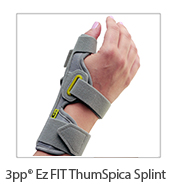|
|
de Quervain's Tenosynovitis

CAUSES OF DE QUERVAIN'S
De Quervain's Tenosynovitis (Dee-quare-vanes-T-no-sigh-no-vie-tis) also known as Mommy's thumb is a painful condition caused by inflammation and swelling in the tendons on the thumb side of the wrist and up the side of the forearm. Although the exact cause of de Quervain’s Tenosynovitis isn't known, side to side repetitive movements of the hand and wrist or chronic overuse from lifting can contribute to it. Working in the garden, knitting, bowling or golfing are common activities that can lead to or make de Quervain’s Tenosynovitis worse. Other causes include a wrist injury, scar tissue that restricts movement of the tendons or rheumatoid arthritis also known as inflammatory arthritis. For more information on de Quervain's, check out our blog - I Think I Have de Quervain’s – What Should I Do About It?
Also check out our Splints and Braces for de Quervain's
RISK FACTORS FOR DE QUERVAIN'S
Many times de Quervain’s can occur with no known cause or activity, but there are certain factors that can increase the risk of developing it.
These risk factors include:
- Your age - If you're between the ages of 30 and 50, you have a higher risk of developing it
- Jobs or activities that involve repetitive motions or twisting of the wrist
- Female - de quervain's is more common in women
- Pregnancy - fluctuating hormone levels can make inflammation more likely
- Caring for a baby - Lifting a baby can put strain on your thumbs (sometimes known as "mommy thumb")
SYMPTOMS OF DE QUERVAIN'S
You have pain and/or swelling near the base of your thumb and along the thumb side of your wrist You have pain that radiates from your thumb that then runs along the thumb side of the forearm, especially when bending your wrist down as you make a fist It's difficult to make a fist, grab an item or cradle the back of an infant's head with your thumb outstretched You have tenderness with pressure over the tendons at the bottom of your thumb
WHAT CAN I DO ABOUT DE QUERVAIN'SNon surgical treatments to help relieve the pain and swelling, include applying an ice pack/cold pack and taking anti-inflammatory medications such as aspirin, ibuprofen(advil) or naproxen(aleve). Resting your thumb by limiting movement and avoiding certain activities that make your symptoms worse can also be helpful. Physical therapy or exercises given to you by a hand therapist can help strengthen your thumb and wrist and improve your range of motion. Wearing a splint or brace that keeps your thumb in an extended position, with the wrist in a neutral position can reduce your swelling and gives your tendons time to heal.
Other treatment options include, a corticosteroid injection and surgery. A cortisone shot into the area around the tendons can help to temporarily relieve your symptoms. Surgery releases the tendon sheath so your can move your thumb and wrist more easily.
Ignoring the symptoms will not make de Quervain’s go away. It‘s always recommended to treat it early and to consult with your health care provider or a hand therapist if your symptoms persist. Without proper treatment, healing may take longer than normal and your symptoms could get worse.
THUMB AND WRIST BRACES THAT CAN HELP
Depending on the severity of your condition, there are several splints/braces that can be used to rest your thumb and wrist.
(Click on the images below for more information on these orthopedic products)


|
|
|
|